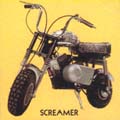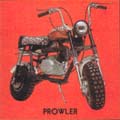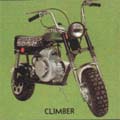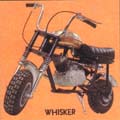Twist or Thumb Throttle




The choice between a twist throttle and a thumb throttle for a minibike depends on personal preference and the specific requirements of the minibike.
A twist throttle, which is commonly used on minibikes and other motorized vehicles, has its own set of pros and cons. Let's start with the advantages, or the pros:
- Control and Precision: A twist throttle allows for precise control of the vehicle's speed and acceleration. The throttle response is directly proportional to the amount the throttle grip is twisted, providing smooth and fine-tuned control.
- Ergonomics and Comfort: Many riders find twist throttles to be ergonomically comfortable and intuitive to use. The twisting motion can be more natural and less fatiguing for the hand and wrist compared to other throttle types.
- Quick Action: The twisting motion of a twist throttle allows for quick and immediate throttle response. This can be advantageous in situations that require rapid acceleration or maneuvering.
- Reduced Hand Fatigue: With a twist throttle, riders can vary their grip and hand position on the handlebar, reducing the risk of prolonged hand fatigue and discomfort.
Now let's take a look at the disadvantages, or the cons of a twist throttle:
- Accidental Acceleration: One potential disadvantage of a twist throttle is the risk of unintentional acceleration. In situations where the rider's hand slips or jerks unexpectedly, there is a chance of unintended throttle input, which can lead to loss of control.
- Limited Hand Movement: Unlike other throttle types, a twist throttle requires continuous hand contact and twisting motion to maintain throttle input. This may limit the ability to perform certain hand movements or adjustments while riding.
- Fatigue in Extended Use: Some riders may experience hand fatigue or discomfort during prolonged use of a twist throttle. Constantly maintaining a twisted grip can strain the muscles and joints of the hand and wrist, especially on longer rides.
- Potential for Overexertion: In certain riding conditions or with powerful minibikes, the force required to twist the throttle can be significant. Overexertion or excessive force on the throttle can lead to fatigue or strain on the hand and forearm muscles.

Riders should choose a throttle type that suits their comfort, experience, and riding conditions, and always practice safe and responsible throttle control. Consider factors such as convenience, reliability, ease of use, and the overall aesthetic you desire for your minibike. Now let's look at thumb throttles.
How About a Thumb Throttle?
A thumb throttle, also known as a thumb lever or thumb throttle control, is an alternative type of throttle more often seen on ATV's and some other recreational vehicles. There are pros and cons of a thumb throttle, let's start with the advantages:
- Precise Control: Thumb throttles offer precise control over the vehicle's speed and acceleration. The throttle response is directly proportional to the pressure applied with the thumb, allowing for fine-tuned control and gradual acceleration.
- Safety and Control in Rough Terrain: The thumb throttle allows riders to maintain a firm grip on the handlebars while operating the throttle. This can be advantageous in rough terrain or off-road conditions where maintaining control and stability are crucial.
- Reduced Risk of Unintentional Acceleration: Thumb throttles are less prone to accidental acceleration compared to twist throttles. The thumb rests on the throttle lever, and intentional thumb pressure is required to engage the throttle, reducing the risk of unintended acceleration due to hand slips or jerks.
- Ease of Use for Beginners: Thumb throttles are often considered more user-friendly for beginners or riders transitioning from other vehicles. The simple up and down movement of the thumb is relatively easy to grasp and control, allowing for a smoother learning curve.
Some of the disdvantages or cons to the thumb throttle are.
- Hand Fatigue: Some riders may experience hand fatigue or discomfort during extended use of a thumb throttle. The constant pressure on the thumb can strain the muscles and lead to fatigue, especially on longer rides or in challenging riding conditions.
- Limited Hand Movement: Thumb throttles require continuous thumb contact and pressure to maintain throttle input. This limited hand movement may make it challenging to perform certain maneuvers or adjust hand position on the handlebars.
- Reduced Grip Strength: Compared to other throttle types, thumb throttles require a downward thumb pressure, which relies on the strength and dexterity of the thumb muscles. Riders with weaker grip strength or those with hand or wrist issues may find thumb throttles more challenging to operate.
- Thumb Positioning: The positioning of the thumb on the throttle can affect the control and comfort. Riders need to find a comfortable and secure thumb position that allows for effective throttle control without compromising their overall grip on the handlebars.
As a minibike connoisseur, it is essential to consider personal comfort, experience, and the specific requirements of your minibike and riding style when choosing a throttle type. Practice and familiarization with any throttle type are necessary to ensure safe and controlled operation.
Enjoy the website...
About AMB
AMB is a minibike fan site dedicated to minibikes of the 1960's and 70's. We appreciate minibikes from the all the manufacturers of the time period like Arctic Cat, Rupp, Trail Horse, Sears minibikes, Suzuki minibikes, MTD minibikes, Bronco minibikes, Benelli, Manco, Kawasaki minibikes, and Ski-Wee.
See Also: Pull or Kick Start | Twist or Thumb Throttles | Minibike Articles | Minibike Lifestyle | The Minibike Handlebar




